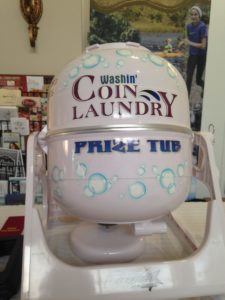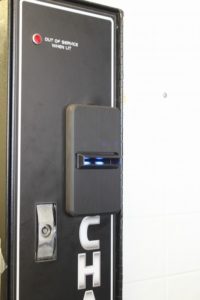Welcome To The Coin Laundry Industry
Congratulations on taking the first step.
Owning a coin laundry, or two, or three allows you the freedom to own a business that does not require your time to operate. Customers will pay you while they do the work.
My Team and I are here to guide you through the process from design to operation. Many of our team own multiple, successful stores and are experienced in all areas of design, construction, operation, and marketing to make your new store the best in the area.
Please take some time to read through the attached article and become familiar with the industry and trends.
Should you have any additional questions or would like to discuss the location of your new store please contact me at:
Ken@WashinCoinLaundry.com
800-792-1941 ext 2
Definitions and Background
The term coin laundry is defined as commercial-grade, self-service laundry equipment placed into service in a retail space. Coin laundries generally occupy the retail space on long-term leases (10-25 years) and generate steady cash flow over the life of the lease. Coin laundries are unique small businesses in that they have no inventory or receivables. A minority of coin laundries employ attendants.
Coin laundries can range in market value from $50,000 to more than $1 million and can generate cash flow between $15,000 and $200,000 per year. Business hours typically run from 6 a.m. to 10 p.m. The stores usually occupy 1,000 to 5,000 square feet of retail space, with the 2002 average being 2,260 square feet.
Coin laundries are perfect examples of passive income generators.
Coin laundries are also referred to as coin-op laundries, coin-operated laundries or Laundromats.
The primary customer base for coin laundries are people living in rental housing. Between 2000 and 2012 the number of people in rentals increased from 86 million to 94 million based on US Census information. The secondary customer base consists of the non-rental population, which also uses coin laundries.
As the chart below shows the homeownership rate in the US continues to decline.

Coin laundries thrive in periods of both growth and recession. During periods of recession, when home ownership decreases, the self-service laundry market expands as more people are unable to afford to repair, replace or purchase new washers and dryers, or as they move to apartment housing with inadequate or nonexistent laundry facilities. The market size grows proportionately to the increase in population.
While coin-ops are found in virtually all neighborhoods across the country, stores seem to perform exceptionally well in predominately renter-occupied, densely populated areas. These areas are increasing in number with each year throughout the country. The intense population growth, coupled with the expansion of rental housing, has increased the customer base for coin laundries.
The public will always need this basic health service – people always need to wash clothes!
Trends and Characteristic
Industry growth is based on the demographics of population density, population mix, and population income. The more concentrated the population, the greater the need for quality coin laundry facilities. National and regional demographics indicate renters, the primary users of coin laundries, are the fastest-growing segment in the nation. As of the 2011 U.S. Census, 35.4 percent of the nation’s 113 million households were renter-occupied.
Operations and Performance Levels
Coin laundry operations consist of three basic areas: janitorial, maintenance and the handling of money (which consists of collections and loading coin changers). Bookkeeping, administration, and banking are typically off-site management areas. A standard profit and loss statement for a coin laundry typically includes the following line items:
-
Income, consisting of wash and dry
- Other income, which would include vending, dry cleaning and/or wash-dry-fold service Expense categories would typically consist of:
-
Accounting
- Advertising
- Insurance
- Legal costs
- Licenses
- Maintenance (includes parts and labor)
- Payroll (usually limited to on-site work–i.e., janitorial or employees)
- Personal property tax
- Rent
- Common Area Maintenance (CAM) charges, also known as Net charges including: real estate taxes, maintenance, insurance and other charges
- Utilities (gas, water, electric and sewer)
- Vending expenses
- Miscellaneous costs (including: wholesale drycleaning costs, fluff-n-fold supplies, and labor)
The percentage for each category will vary from store to store and region to region. Interest charges, depreciation and other non-standard items, such as owner salary, generally appear on tax returns but are excluded from the standard profit and loss statement for purposes of valuation and determination of cash flow. There are some general ‘Rule Of Thumb” percentages that we can discuss.
- Sales volume, and/or individual store performance varies, based on a number of factors. These factors may include demographics; overall services offered; design and general condition; equipment selection, condition and vend prices; hours of operation; exposure of the building; parking; and competition.
- The industry terminology for individual equipment performance is cycles per day, or turns per day (TPD). These designations refer to the number of times per day, on average, each machine is used. While this statistic varies widely the range for washing machines is generally from three TPD to as high as eight TPD or more. The primary factors affecting TPD include: population demographics, such as density and percentage of renters; capacity and quantity of the washers; the vend prices charged; and the prevailing market vend prices. Dryer income can vary greatly due to: total wash poundage generated; overall vend prices of both washers and dryers; heating efficiency of dryers; total number of dryers in relation to washers; and dryer size and capacity. Dryer income is usually expressed as a percentage of overall income. Summary
Today’s coin laundry industry is a strong and vibrant one. Even more appealing is the fact that this dependable public service industry continues to grow and thrive. The demographic trends toward an even greater apartment dwelling segment of the population predict continued prosperity.
If you have
- I look forward to meeting you, Ken Barrett
- Ken@WashinCoinLaundry.com
- WashinCoinLaundry.com
-
800-792-1941 ext 2





